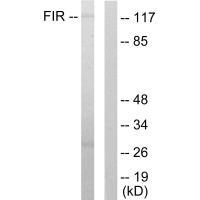
| WB | 咨询技术 | Human,Mouse,Rat |
| IF | 咨询技术 | Human,Mouse,Rat |
| IHC | 咨询技术 | Human,Mouse,Rat |
| ICC | 技术咨询 | Human,Mouse,Rat |
| FCM | 咨询技术 | Human,Mouse,Rat |
| Elisa | 咨询技术 | Human,Mouse,Rat |
| Aliases | FERM; RhoGEF and pleckstrin domain protein 2; FGD1-related Cdc42-GEF; FIR; FRG |
| Entrez GeneID | 9855; |
| WB Predicted band size | 119kDa |
| Host/Isotype | Rabbit IgG |
| Antibody Type | Primary antibody |
| Storage | Store at 4°C short term. Aliquot and store at -20°C long term. Avoid freeze/thaw cycles. |
| Species Reactivity | Human,Mouse |
| Immunogen | Synthesized peptide derived from Internal of human FIR. |
| Formulation | Purified antibody in PBS with 0.05% sodium azide. |
+ +
以下是关于FIR抗体的3篇参考文献及其摘要概述:
---
1. **文献名称**:*"Autoantibody against DNA replication factor FIR (FBP-interacting repressor) in esophageal squamous cell carcinoma"*
**作者**:Sugito, K. et al.
**摘要**:该研究在食管鳞状细胞癌患者血清中发现FIR抗体,揭示了其作为潜在肿瘤标志物的价值。FIR蛋白参与细胞周期调控,其抗体可能反映肿瘤发生中的异常DNA复制过程。
---
2. **文献名称**:*"FBP-interacting repressor (FIR) suppresses transcriptional activity of the c-MYC promoter by directly binding to DNA"*
**作者**:Kojima, T. et al.
**摘要**:研究利用FIR抗体通过染色质免疫沉淀(ChIP)技术,证实FIR通过结合c-MYC启动子抑制其转录活性,揭示了其在癌症中调控原癌基因表达的分子机制。
---
3. **文献名称**:*"FIR regulates expression of genes involved in proliferation and metastasis in colorectal cancer cells"*
**作者**:Nakamura, Y. et al.
**摘要**:通过FIR抗体介导的蛋白质检测,研究发现FIR在结直肠癌细胞中调控增殖和转移相关基因(如MMP9),提示其可能成为癌症治疗的潜在靶点。
---
这些文献均通过FIR抗体探索了该蛋白在癌症中的功能机制及临床价值。如需具体文章,可通过PubMed或Sci-Hub输入标题获取全文。
×